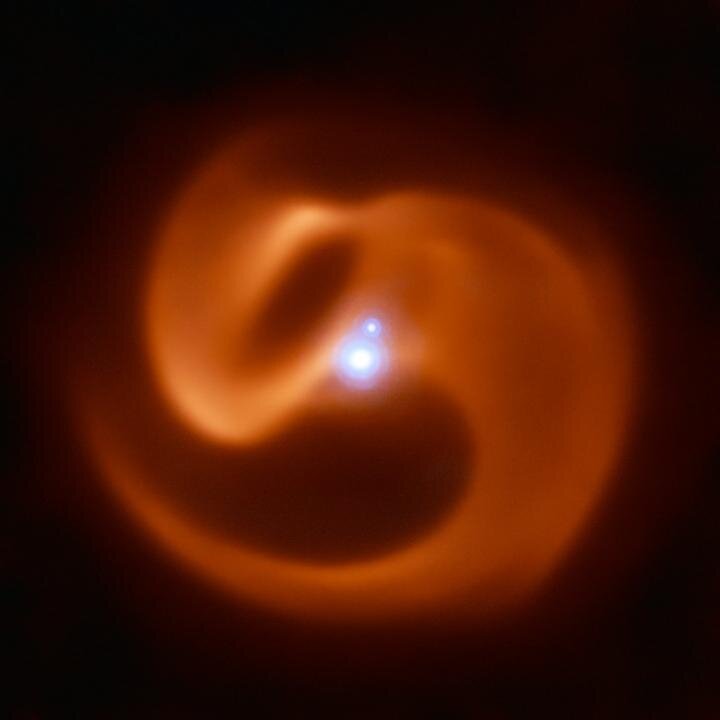While on COVID lockdown, a University of Sydney honours student has written a research paper on a star system dubbed one of the “exotic peacocks of the stellar world”.
Only one in a hundred million stars makes the cut to be classified a Wolf-Rayet: ferociously bright, hot stars doomed to imminent collapse in a supernova explosion leaving only a dark remnant, such as a black hole.
Rarest of all, even among Wolf-Rayets, are elegant binary pairs that, if the conditions are right, are able to pump out huge amounts of carbon dust driven by their extreme stellar winds. As the two stars orbit one another, the dust gets wrapped into a beautiful glowing sooty tail. Just a handful of these sculpted spiral plumes has ever been discovered.
The object of this study is the newest star to join this elite club, but it has been found to break all the rules.
“Aside from the stunning image, the most remarkable things about this star system is the way the expansion of its beautiful dust spiral left us totally stumped,” said Yinuo Han, who completed the research during his honours year in the School of Physics.
“The dust seems to have a mind of its own, floating along much slower than the extreme stellar winds that should be driving it.”
Astronomers stumbled across this conundrum when the system was discovered two years ago by a team led by University of Sydney Professor Peter Tuthill. This star system, 8000 light years from Earth, was named Apep after the serpentine Egyptian god of chaos.
Now Mr Han’s research, published in the Monthly Notices of the Royal Astronomical Society, confirms those findings and reveals Apep’s bizarre physics with unprecedented detail.
Applying high-resolution imaging techniques at the European Southern Observatory’s Very Large Telescope at Paranal in Chile, the team was able to probe the underlying processes that create the spiral that we observe.
“The magnification required to produce the imagery was like seeing a chickpea on a table 50 kilometres away,” Mr Han said.
PRECISE MODEL
The team went further than confirming the earlier discovery, producing a model that matches the intricate spiral structure for the first time, advancing scientists’ ability to understand the extreme nature of these stars.
“The fact this relatively simple model can reproduce the spiral geometry to this level of detail is just beautiful,” Professor Tuthill said.
However, not all of the physics is straightforward. Mr Han’s team confirmed that the dust spiral is expanding four times slower than the measured stellar winds, something unheard of in other systems.
The leading theory to explain this bizarre behaviour makes Apep a strong contender for producing a gamma-ray burst when it does finally explode, something never before witnessed in the Milky Way.
Dr. Joe Callingham, a co-author of the study from Leiden University in the Netherlands, said: “There has been a flurry of research into Wolf-Rayet star systems: these really are the peacocks of the stellar world. Discoveries about these elegantly beautiful, but potentially dangerous objects, is causing a real buzz in astronomy.”
He said this paper was one of three to be published this year on the Apep system alone.Recently, the team demonstrated that Apep was not just composed of one Wolf-Rayet star, but in fact two. And colleagues from the Institute of Space and Astronautical Science in Japan will soon publish a paper on another system, Wolf-Rayet 112. Lead author of that paper, Ryan Lau, was a co-author on this paper with Mr Han.
TIME BOMBS
Wolf-Rayet stars are massive stars that have reached their final stable phase before going supernova and collapsing to form compact remnants such as black holes or neutron stars.
“They are ticking time bombs,” Professor Tuthill said.
“As well as exhibiting all the usual extreme behaviour of Wolf-Rayets, Apep’s main star looks to be rapidly rotating. This means it could have all the ingredients to detonate a long gamma-ray burst when it goes supernova.”
Gamma-ray bursts are among the most energetic events in the Universe. And they are potentially deadly. If a gamma-ray burst were to impact Earth, it could strip the planet of its precious ozone layer, exposing us all to ultra-violet radiation from the Sun. Fortunately, Apep’s axis of rotation means it presents no threat to Earth.
‘MIND-BLOWING’
The numbers reveal Apep’s extreme nature. The two stars are each about 10 to 15 times more massive than the Sun and more than 100,000 times brighter. Where the surface of our home star is about 5500 degrees, Wolf-Rayet stars are typically 25,000 degrees or more.
According to the team’s newest findings, the massive stars in the Apep binary orbit each other about every 125 years at a distance comparable to the size of our Solar System.
“The speeds of the stellar winds produced are just mind-blowing,” Mr Han said. “They are spinning off the stars about 12 million kilometres an hour; that’s 1 percent the speed of light.
“Yet the dust being produced by this system is expanding much more slowly, at about a quarter of the stellar wind speed.”
Mr Han said that the best explanation for this points to the fast-rotating nature of the stars.
“It likely means that stellar winds are launched in different directions at different speeds. The dust expansion we are measuring is driven by slower winds launched near the star’s equator,” he said.
“Our model now fits the observed data quite well, but we still haven’t quite explained the physics of the stellar rotation.”
Mr Han will continue his astronomical studies at the University of Cambridge when he starts his doctorate later this year.
Doomed star in Milky Way threatens rare gamma-ray burst
More information:
Y Han et al, The extreme colliding-wind system Apep: resolved imagery of the central binary and dust plume in the infrared, Monthly Notices of the Royal Astronomical Society (2020). DOI: 10.1093/mnras/staa2349
Provided by
University of Sydney
Citation:
In the eye of a stellar cyclone: Bizarre secrets of a ticking time-bomb star (2020, October 12)
retrieved 12 October 2020
from https://phys.org/news/2020-10-eye-stellar-cyclone-bizarre-secrets.html
This document is subject to copyright. Apart from any fair dealing for the purpose of private study or research, no
part may be reproduced without the written permission. The content is provided for information purposes only.



